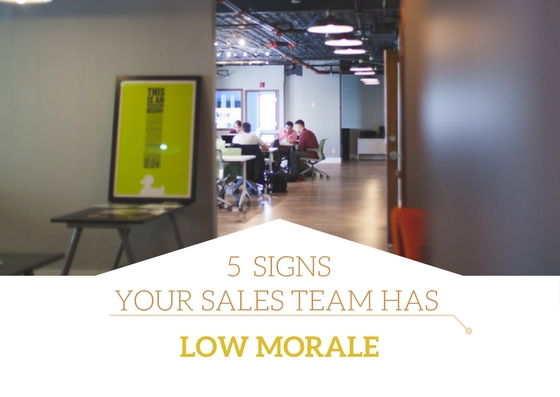5 Warning Signs Your Sales Team Has Low Morale

The foundation of most business is sales. Whether it’s the sale of a product or a service, if your business is unable to make sales, you’ll soon have no business to speak of. It’s important to take action at the first signs of a problem with your sales staff to boost low morale and get people back on the track to success. Here are 5 warning signs that your sales team may be having a problem, and a few tips on how to boost employee morale.
1. Loss of Interest
A sudden loss of interest from some or all of your sales team is a pretty good indicator that something is wrong. While the occasional rut can be expected, a rut that lasts longer than usual or spreads to multiple people on the team is a sure sign of a much bigger problem. If you notice a loss of interest among employees, take the time to pull them aside individually and talk to them about what’s happening—addressing the issue and finding a solution can quickly get your team back on track.
2. Change in Attitude
The typical attitude among sales staff is one of motivation and excitement, so any negative change in attitude is the sign of a problem. Determining the cause of this attitude change can help you figure out how best to re-motivate your employees, whether they need a change in the sales tactics they use or recognition of a job well done.
3. Drop in Performance
When your sales team stops turning in the same numbers they used to, it’s time to act quickly. Taking inventory of the situation can help you determine whether numbers typically drop at this time of year, or if your employees’ poor performance is to blame. If it’s not the slow season, consider talking to them to determine why your employees are lacking confidence and see what resources you can provide to help boost their performance.
4. Uncooperative
The sure sign of low morale among employees is an uncooperative attitude. When employees start pushing back and fighting against you, something is seriously wrong and must be addressed immediately before it gets worse. Show your employees that you’re all on the same team and willing to work together to begin rebuilding their confidence in you and the business as a whole.
5. Decrease in Commitment
A decrease in commitment can be seen in all of the above-mentioned signs of low morale, but is also exemplified in employees who begin to stop showing up for work, show up late, and just plain don’t care anymore. At the first signs of this problem, you need to pull the employee or employees aside and have a conversation about what they want, then commit to helping them recommit to your business. If this doesn’t work, it may be time to part ways with this employee.
Start Boosting Morale Today
If you lead a medium-to-large organization, boosting morale for your entire team can be quite the challenge. However, with a gamification platform that integrates with all your tools and metrics, you can easily:
- Recognize milestones like work anniversaries
- Celebrate achievements, even small ones
- Generate momentum with friendly competition among team members
- Give employees goals to work towards, that get progressively more challenging
- Recognize outstanding performance
With IActionable, you can recognize your employees for their accomplishments and encourage them through their disappointments—be the type of boss you would like to have, and you’re sure to notice an increase in morale among your sales staff. After all, improving employee performance is essential to maintaining a successful business.



 157 million. That’s the number of
157 million. That’s the number of